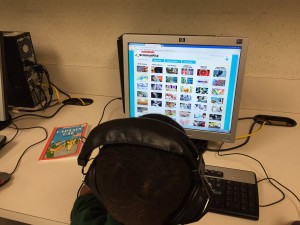

This year I am attempting a new Guided Inquiry project. I meet with fourth graders in the computer lab two days a week for an hour for inquiry based lessons that are planned with the Guided Inquiry Design model.
The first lesson I have designed and implemented is one stemming from a State of Texas 3/6 grade reading list called the Texas Bluebonnet program. The Texas Bluebonnet Program publishes a new list of books from a wide range of genres each year. Students in 3-6 grades read at least five books and then vote on their favorite at the end of January. The winning author is honored at a luncheon at the state library conference and a group of students are invited to present the author the award.
One of the books on the list this year is Space Case by Stuart Gibbs. The introduction in the book is a letter to the reader that welcomes them to the first permanent human habitation on the moon.
I used this letter/introduction as the Open to our first GI project. I then had students spend a few minutes thinking about what it might be like to be sent to live on the moon. We opened a Google Doc and students jotted down notes, thoughts, ideas, and questions. Must not forget the questions!
Boy were the questions, thoughts and ideas good ones! As was the enthusiasm from the students. At first the students weren’t sure what to write and so, one by one questions started coming out. I would answer their questions by saying something like “Wow, that is a great question, write it down!” I also did some of my own wondering on my paper; things like I wonder what it’s like on the moon…do they have a day and night. I only put a few on my Google Doc and that sparked the ideas, thoughts and questions. I also was sure to say, “These are my thoughts, I’m sure most of you have different thoughts than mine.”
I then introduced the students to 3 of our district online resources such as Britannica, Scienceflix and PebbleGo. I had them look at the sites; explore what was on them about the moon. It was so thrilling to see the students excited about using the online resources rather than “Googling it.” I fully support Google; don’t get me wrong, but our fourth grade students need a place to go to find legitimate, readable sites on their level.
I can’t tell you how often the students get stuck in Immerse and Explore phases when they use Google, at first. I watch them Google a phrase, often misspelling it, find thousands of websites and proceed to open then close them without reading the first word. They move on to open, close, open, close over and over and then get frustrated. Or, I see students immediately go to images to learn about, say natural resources and spend hours looking at photos without actually learning any specific details. Therefore, it was exhilarating to see them excited about their searches and the information they were oohing-and-ahhing over.

The next class period, I introduced three more district and state sponsored online resources and allowed them to continue exploring to see what they could find about the Moon and potential life on the moon. On the third class meeting, I showed the students a clip from Discovery Education of a modular unit that has plans for use on the moon. I allowed students then to continue exploring other video clips about life on the moon, life in space, space travel, etc.
We again logged into Goggle Drive to take notes and document questions and thoughts as they were exploring. Students were motivated to ask if they could go back to a previous website, or if they could try new ones, and were excited over the details they were finding. I had students ask if they could use specific information databases they knew about that I didn’t introduce, or explore others listed on our district online resources page. The energy for this project is high, even for students who don’t necessarily gravitate toward space or space travel topics. Equally exciting, when I gave them 10 minutes of “free exploration time in district sponsored games and resources” for working so hard, more than half of them chose to stay in the online resources tab to either explore other interests, or continued exploring space topics.
When reflecting upon the lesson with the first group of students, I added a step or two here and there with the next group. I wanted to have students record their thought processes and add a reflection piece as well. Therefore, we had a mini-lesson about logging into our district Google account, opening a document, brainstorming thoughts, adding a title, etc. Students used a Google Doc to jot down thoughts, ideas, questions, and reflections before, during and after exploring online resources. So, see I do support and use Google for education!
We have not finished this unit, our next step will involve a minilesson on academic honesty and citing sources. We then will begin to actually search for answers to our questions, now that we have a good idea of which databases and online resources will be most helpful.
Tara Rollins on twitter
Hi-
How do you teach 4th graders how to take notes? And how to cite sources? Would love to see an outline for this project!
Thanks!